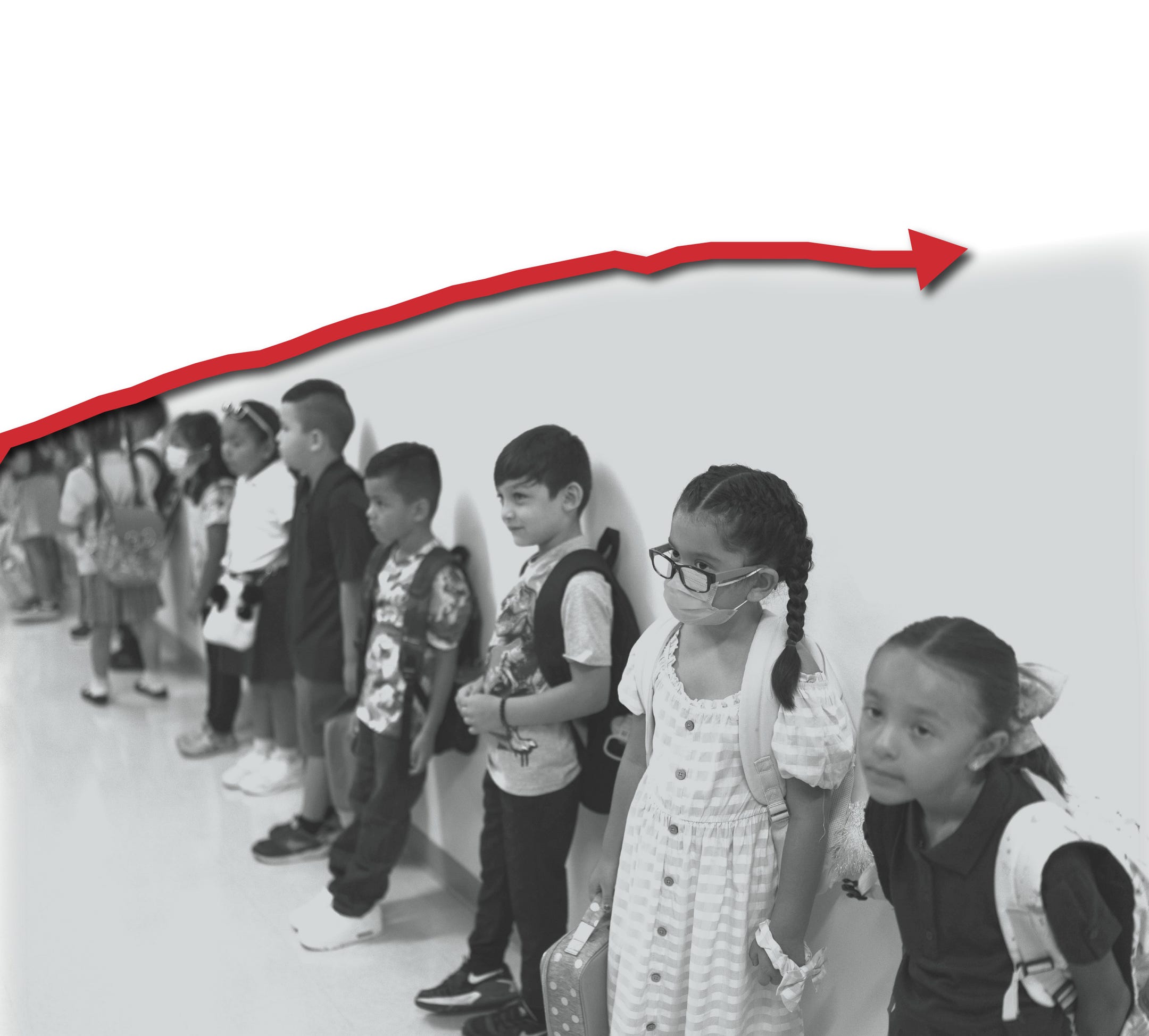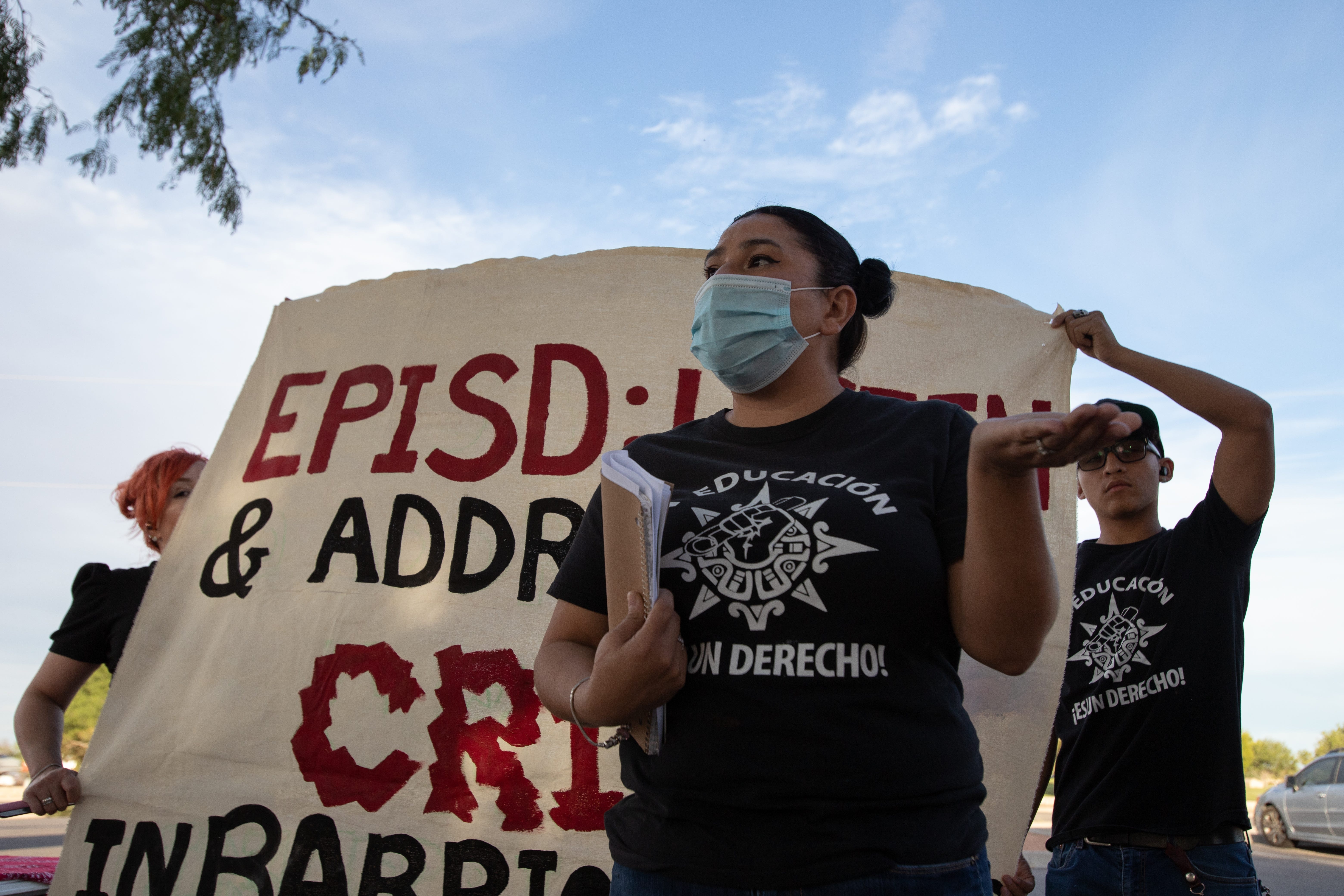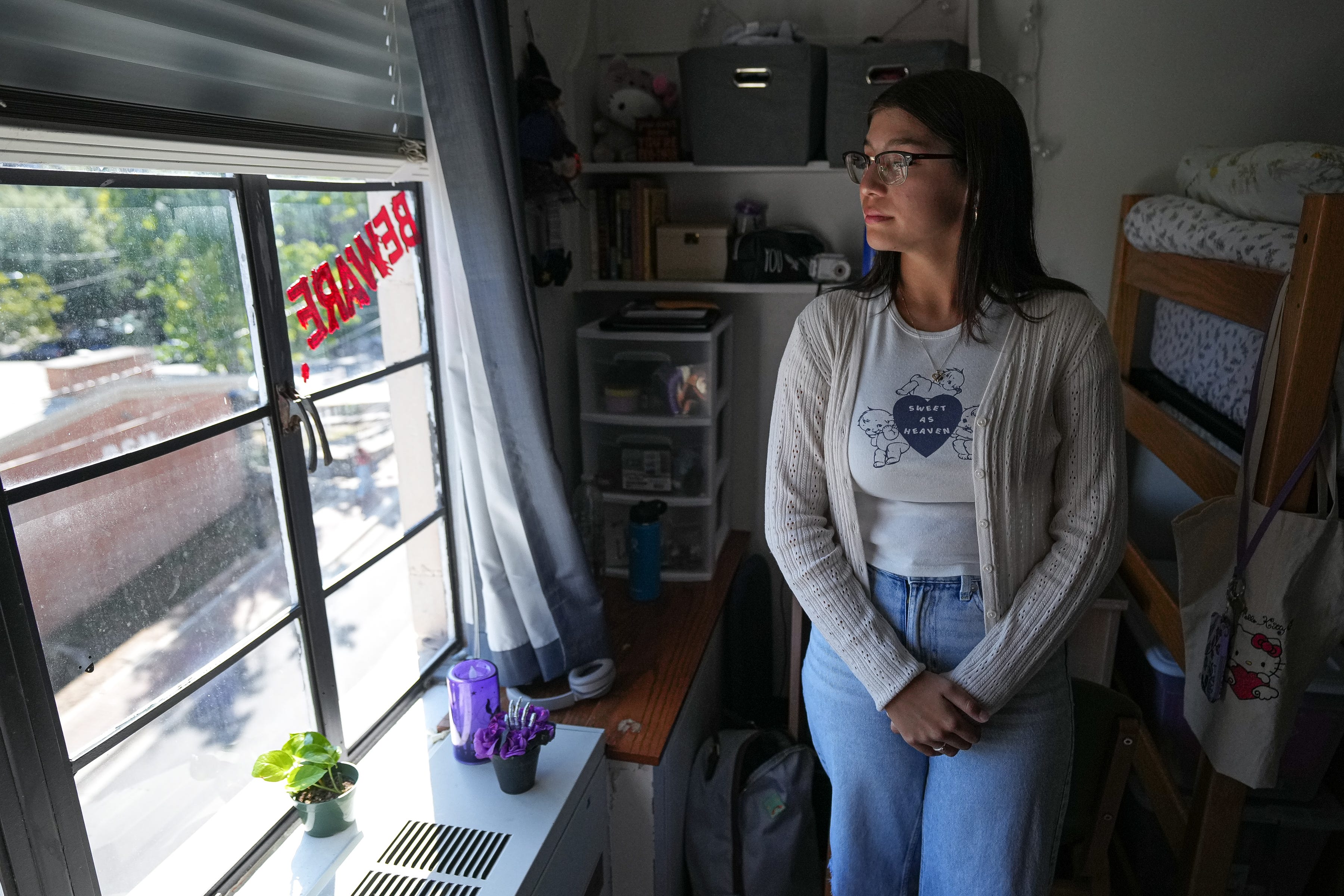
In late September in El Paso, Texas, residents of the Chamizal barrio and mothers Cemelli de Atzlan and Hilda Villegas held a vigil. They were mourning what they consider a crisis in barrio schools: pandemic disruptions, a shortage of teachers, the lack of culturally sensitive or dual-language programming, overcrowding and historical neglect.
The women, leaders of the group Familias Unidas por la Educación and the group of about 40 who met outside Bowie High School were upset about what they say is a failure of local and federal leadership to invest in the schools in their border town.
“Our fear is what’s going to happen to our children. You added two to three years to the loss of education. What is the future of the 2,000 to 3,000 kids in the barrio?” Villegas said.
The kids who live in the Chamizal community represent some of the tens of thousands of young Latino people in the United States who already are will soon be the second-largest group of students in the nation’s public schools, behind white students. Latinos will comprise nearly 30% of the school population by the end of the decade and white students will make up 43%, data from the Education Department shows. The number of Hispanic students in public schools in every state grew by varying degrees from 2010 to 2021 even as some states faced overall enrollment declines, a USA TODAY analysis of census data found. A rising birth rate among the nation’s Hispanic population, rather than immigration, is the main driver of the increase, the Pew Research Center found.
The growing number of Hispanic or Latino students in public schools means their success is crucial to that of the whole country. Yet schools in places facing booms in Hispanic or Latino student enrollment have a long way to go in accommodating the needs of those students: Hispanic or Latino students saw greater declines than their non-Hispanic or Latino white peers on recent standardized tests.
More: 'Largest score decline' in reading for nation's 9-year-olds, first-ever drop in math
Education experts, advocates and parents say these students need lessons and school environments that consider their diverse ethnic backgrounds, more access to information translated into Spanish, a greater number of Latino educators, and better support as they pursue higher education – and they need it all to happen fast – if they want these students to remain enrolled.
Where large Latino populations have been the norm, such as Texas and California, even more will be required to help those students recover from years of learning loss because of the pandemic: Although Latino children make up more than half of the population in Texas, the state ranks near the bottom compared with others when it comes to per-pupil spending, according to the Edunomics Lab, a research center at Georgetown University. Yet most districts rely heavily on state and local dollars. For schools in high-poverty Latino communities, more federal money could make a big difference, Villegas said, and help couldn't come soon enough. El Paso School District's Chief Financial Officer Martha Aguirre said schools in the barrio Chamizal don't receive extra funding specifically for being near the U.S.-Mexico border.
In August, Familias Unidas por la Educación wrote to Education Secretary Miguel Cardona to share their concerns as “one of the most immigrant, Spanish-speaking, low-income neighborhoods in El Paso, TX” arguing the El Paso district can’t help them alone because it gets no extra money for being near the border and asking the department to “declare the barrio schools a disaster area so they can receive the needed help” to address historical neglect.

Cardona recently said his agency is working to "raise the bar for Latino student success and provide our communities with equitable and inclusive opportunities to learn, grow and pursue the American Dream."
What concerns Latino families?
“As the number of Latino students grows, will we create schools that nurture their strengths and meet their needs?” a 2022 report on Latino Student Success from the national group UnidosUS asks. “Do we double down on what works – like equitable funding, targeted support for English learners, and inclusive schools – or do we accept the status quo and setbacks caused by the pandemic as irreversible? And will we recognize that today’s Latino students must be our priority because they will shape our nation for generations to come?”
Latino parents – more involved in their children’s education than ever after pandemic school-closures – are demanding school leaders better accommodate their families, including providing information and translation in Spanish to help them engage with their local school boards and learn more about the nuanced workings of the American education system.
A survey of 1,228 parents by Conoce tus Opciones Escolares and the group National School Choice Week found that parents who identify as Hispanic or Latino are becoming more familiar with school choice after pandemic-related school closures. The survey shows 30% or more of those parents are considering full-time homeschooling, another public school outside their home district, or a public charter school amid "persistent achievement gaps and widespread pandemic-related disruptions to K-12 education." Another 25% are considering private or faith-based schools.
Public school advocates worry those options don’t provide the best education, will leave the poorest Latino students behind and fear the departures from neighborhood public schools could further segregate their communities.
In higher education, colleges are looking to attract more Latino students, especially as overall enrollment declines. Prospective and current college students say they are looking for more from these institutions and universities, including more help paying their tuition. Natalie Ochoa, 18, a freshman at Texas State University, said she’s hungry for inclusive Latino-specific programming on her campus far from home. Leslie Rangel, a freshman at the University of South Carolina, said she has only one Hispanic teacher’s assistant and wishes there were more professors at her school that looked like her.
Where is the population of Latino students growing?
A 2018 Pew Research Center report says Hispanic/Latinos are the nation’s “youngest major racial or ethnic group.” Places where Hispanic/Latino populations have historically been small saw the fastest growth, including North Dakota and Georgia. In Harris County, Texas, which includes Houston, the Hispanic population grew by 363,000 over the past 10 years, more than in any other county. The size of the increase was larger than the entire Latino population in 23 states and Washington, D.C., the analysis found.
USA TODAY analyzed U.S. census data on the school-age population in America. All states saw an increase of Hispanic/Latino people ages 5 to 18 when comparing 2011 with 2021.
USA TODAY's analysis of 2021 U.S. census data on the country's school-age population in America found New Mexico (61.1%) has the highest percentage of Hispanic/Latino people ages 5 to 18, followed by California (52.2%), Texas (49.1%), Arizona (44.3%), Nevada (41.4%), Colorado (31.7%), Florida (31.5%), New Jersey (27.4%), Rhode Island (26.3%) and Connecticut (25.3%).
Los Angeles County in California has the largest number of Hispanic/Latino people of any county in the country.
Latino student achievement experts have said states and schools need to understand and adapt to the varying cultures within the overarching Latino community. Of the 62.5 million Latinos in the U.S. recorded in census data in 2021, people of Mexican origin make up the majority at about 60% of all Latinos, followed by people of Puerto Rican, Salvadoran, Cuban, Dominican, Guatemalan, Colombian and Honduran origins. The fastest population growth among Latinos in the nation comes from those with origins in Venezuela, the Dominican Republic, Honduras and Guatemala, the analysis shows.
“We get clustered into this diversity, but Latino culture is not a monolith. In this space it’s really important to understand what being a first-generation immigrant Latino is, what being a DACA recipient is, what being a male versus a female teacher is,” said Feliza Ortiz-Licon, chief policy and advocacy officer for the national nonprofit Latinos for Education.
What do Latino students need? Can education adapt for Latino students?
For starters, advocates are working to grow the number of Latino teachers. In Miami, Edgar Palacios grew up with Latino teachers as role models. The school he attended celebrated his Latino heritage and the Spanish language he spoke at home. He said he realized his experience wasn’t the same for all Latino young people when he moved to Spokane, Washington, where he was called a “dirty Mexican.”
Now, as the founder of nonprofit group Latinx Education Collaborative, Palacios works on retaining and growing K-12 Latino education professionals in Kansas City, Missouri. It’s one of many school districts across the country where the proportion of Latino students and teachers don’t align, according to a UnidosUS study from September 2019.
“I think schools across the board – whether they’re traditional or charter – struggle with the fact they don’t have enough Latino teachers or Latinos in leadership, especially in the Midwest where there are emerging Latino communities,” Palacios said. “It’s intensive work, and it’s about starting early and planting the seed.”
In 2021 in Kansas City, Latino students made up nearly 28% of all public school kids while Latino teachers made up 6%, a district spokesperson said. The Kansas City Public School district over the past several years has helped increase the number of Black educators through mentoring programs and is now “working to create the same support systems for Latinos entering education,” district spokesperson Hope Soriano-McCrary wrote in an email.
Expanding the Latino teaching workforce could help with another need advocates identify: more bilingual education that allows kids to learn in Spanish and English and more readily available Spanish translation of school-related materials. Federal data shows Spanish was the home language of more than 75%, or 3.9 million, of all English-language learners in public schools and 7.9% of all students in fall 2019.
The UnidosUS report notes that 12 states have English learner populations that exceed 10% of the total student population, “yet students’ native language skills are often viewed as an obstacle to overcome in attaining English proficiency.”
“Multilingualism should be recognized and celebrated as an asset that helps all students, rather than a limitation," the report says.
In addition, said Tania Valencia, a policy analyst who focuses on K-12 education at UnidosUS, “we believe English learners also deserve the opportunity to learn in Spanish."
Last year, California became the first state to require all high school students to take and pass an ethnic studies course to graduate. It includes lessons on Latino heritage and history. Students need more of that, said Eve Delfin, the Latino Student Achievement Specialist for the Oakland Unified School District’s Office of Equity. During Hispanic Heritage Month in late September, Delfin said she attended a “coffee with the principal" event at one of the district’s schools to help administrators better understand what Latino students and parents want from their education, including curriculum.
“Many of my students districtwide tell me they want to learn more about their history and their culture. And when they learn more and dig deeper into their heritage, they feel value in addressing the historical trauma we’ve been facing for decades,” Delfin said.
While California stands out for requiring a course to graduate, other states are creating courses or incorporating lessons into existing classes, according to a report from the nonprofit organization WestEd's Center for Standards, Assessment, and Accountability.
Debt relief will change the lives of some with student loans: But fall short for others.
For Latino students, the price of college is a challenge
Ochoa said she felt hopeless about being able to afford college until she received a McDonald’s HACER scholarship designated to help Hispanic students like her pursue higher education. Ochoa is one of many Latino students who almost didn’t attend college, worried about the long-term financial consequences and whether they would fit in. Still, Latino enrollment in colleges across the country increased from 2.9 million to 4.1 million from 2010 to 2021, the Pew Research Center found. And 19% of all college students were Latino in 2021, up from 14% in 2010. Despite growing enrollment, Hispanic students are less likely to graduate with college degrees, a recent report from the Pew Research Center says.
More Latino students than ever are trying to get their degree: But it’s fraught and costly
As Latino student enrollment increases, K-12 schools will have the added responsibility of helping those students think about their abilities to pay for, attend and graduate from college.

And colleges where Latinos students aren't the majority will have to adapt to keep the students they enroll. Ochoa, who is midway through her first semester and studying to be a special education teacher, said she misses the primarily Latino community she grew up with in her hometown of Pharr, Texas, and wants colleges to consider the cultures of the students they’re recruiting and hoping to retain.
“I do miss home sometimes. And not having tamales – they don’t have tamales here or things like bingo. Every weekend I would go to bingo with my grandparents. … I didn’t think I would take it for granted,” Ochoa said.
“At my high school, we had different celebrations throughout the year. We celebrated Mexican or Hispanic heritages, we had a Spanish club. Here we've only had one celebration so far beyond Hispanic Heritage month. Schools that want to show they cater to all diversity ... could do better having consistency throughout the entire year."
Contact Kayla Jimenez at kjimenez@usatoday.com. Follow her on Twitter at @kaylajjimenez.